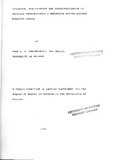| dc.description.abstract | During the past decade, growing public awareness of the
impact of pesticides on food and enviromental safety has
significantly affected the pest control industry. Several
organizations (scientific, consumer, enviromental and
governmental) have called for more severe restrictions on
the use of toxic chemicals and increased funding for the
development of alternative pest control methods (Gelernter,
1990). This has been a major stimulus for renewed interest
in the use of microbial control agents, which have an
excellent safety record and maybe produced using renewable
raw-materials. Many of these agents can be integrated with
chemical and other pest management techniques. Among the
microbial agents that offer great potential in this respect
is Bacillus thuringiensis (B.t.) (Davidson and Sweeney,
1983). B.t. based products account for 90-95% of the total
bio-pesticide markeb_(Feitelson et al., 1992). Worldwide
sales of B.t. products have. grown from $24 million in 1980
to $107 million -in 1989. Annual sale~ a~e forecast to expand
at a rate of 11% teaching $300 millio.n by the year 1999
(Feitelson et al., 1992).
In this study, a newly isolated B.t. strain was cultured
by shake flask fe-rmentation involving two inoculum stages
and a production stage. The a-endotoxin crystals so produced
were isolated by centrifugation on a continuous sucrose
gradient (40-70%). Analysis of the amorphous protein
crystals by SDS polyacrylamide gel electrophoresis, revealed
three major sub-units of molecular weights -25 KD, -66 KD,
and -140 KD. Upon solubilization of the crystal under high
pH and reducing conditions, the resulting supernatant
solution had one major protein sub-unit band (Mr -21 KD),
while the pellet also had one major sub-unit band (Mr -66
KD). Upon protease treatment of the solubilized protoxin and
insoluble protoxin (pellet) fractions using bovine
pancreatic trypsin, a-chymotrypsin, insect larval gut
homogenates (Aedes aegypti, Chilo partellus, Musca
domestica) and partially purified trypsin like protease from
Glossina spp midgut, no apparent change in the molecular
weight of the major proteins was observed. The crystal was
shown to be a glycoprotein with high mannose sugar residues
as demonstrated by staining with periodic acid Schiff
reagent and fluorescein~isothiocyanate conjugated
concanavalin-A~ respectively. The carbohydrate content of
,
the crystal estimated by phenol sulphuric acid method was
0.023 ± 0.0016%. Double radial immunodiffusion experiments
showed that the antisera raised against the Mr -21 KD and Mr
-66 KD protein sub-units did not cro~~-react with the
solubilized protoxins a9tive against Glossina spp (TIKI) and
Chilo partellus/~podoptera exempta (MFB4/2), respectively. | en |

